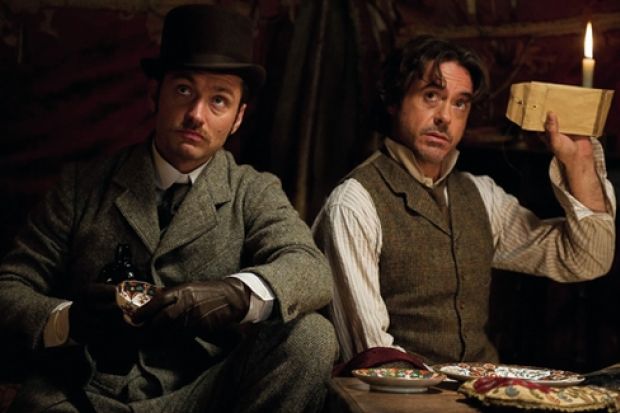Sherlock Holmes: A Game of Shadows
Directed by Guy Ritchie
Starring Robert Downey Jnr and Jude Law
Released in the UK on 16 December
Released on Christmas day in 2009, Guy Ritchie's Sherlock Holmes (starring Robert Downey Jnr and Jude Law) emphasised the physical and cerebral muscularity of Sir Arthur Conan Doyle's iconoclastic sleuth, replete with a signature editing style that elongates and unfurls the passage of time involved in the process of deduction, each thought like a jolt to the nervous system. Since the success of that film, Holmes has also been resurrected by Steven Moffat in his contemporary BBC version (with Benedict Cumberbatch and Martin Freeman). While Ritchie's update is set against a panorama of a kinetically charged Victorian London, Moffat's 21st-century Holmes subtly develops its own muscularity, incisively engaging with Conan Doyle's thematic exploration of the modern condition.
If a comparison is to be made between the endeavours of Ritchie and Moffat then the difference lies, undoubtedly, in the immersive experience of Ritchie's film and his acute response to the original material in ways that make full use of the cinematic medium's voluptuous effects. While the first film's use of slow motion, counterbalanced with rapid editing, was an experimentation with cinematic time, its rhythms and sensations viscerally binding viewers' bodies to the film itself, Sherlock Holmes: A Game of Shadows refines this aesthetic, intensifying the fusion of Holmes' physicality and his equally quickening methods of deduction.
In the first few minutes of the film, a bomb goes off in Strasbourg and we are plunged into an anarchic world on the brink of war, trailing fugitive Gypsies, spying on Irene Adler (Rachel McAdams) and luxuriating in the shimmering light of the belle epoque that sets the scene for Watson's (Jude Law) stag night. While Watson is married to Mary Morstan (Kelly Reilly), a shadow is cast on the festivities in the shape of Moriarty (convincingly played by Jared Harris). While Holmes and Watson help a Gypsy (Noomi Rapace) in her quest to find her brother, Mycroft Holmes (Stephen Fry) ensures the safety of Mrs Watson.
The film's plot is designed to enhance Ritchie's compelling cinematic style, which interweaves moments of stillness and silence with deafening explosions, lingering images of skin-on-skin contact during fight sequences and gunfire. In view of Moriarty's emblematic role as the facilitator of anarchy, the effects of Ritchie's film appear as part of his weaponry, undermining the harmony of Holmes' seemingly mechanised powers of deduction. Indeed, Ritchie especially pays homage to Conan Doyle's The Final Problem, in which Holmes and Moriarty wrestle to their assumed deaths at the Reichenbach Falls. The film seems to be in servitude to Moriarty's fixation on the spectacle of chaos when Ritchie reverses the perspective during the final fight sequence and we watch Moriarty's plan of action unfold, from every knuckle punch to the last swoop across Holmes' face.
While the formal style of Ritchie's film emphasises a kind of chaos that may reinforce the feeling of Moriarty overwhelming Holmes, the most memorable images of the film precisely relate to other types of weaponry and warfare. Several lengthy sequences involve camera angles that seem to inhabit the barrel of a gun with extreme close-ups of bullets passing through in quick succession; these moments take place on board a train bound for Paris and the train itself becomes bullet-like, not only in its suggestion of speed but also in its threat to Holmes and Watson since it shelters vigilantes out to destroy them. Later, a chase scene involves a bullet-peppered sprint through a forest dense with snow, filmed by Ritchie's cinematographer Philippe Rousselot in slow motion so that the characters seem to be caught forever in the frame of the film, reminding us of the Victorian invention of the photographic image and its mysterious freezing of time and connotative, immortalising properties.
Certainly, Ritchie's film strangely channels a Victorian fascination with spectacle similar to the first experience of cinema. As Tom Gunning writes in his reflection on early cinema's "attractions", these films "directly solicit spectator attention, inciting visual curiosity, and supplying pleasure through an exciting spectacle". Ritchie's film not only celebrates the spirit of Victorian industry, it commemorates it through its texture of chaos and ellipses of breathtaking spectacle.
Register to continue
Why register?
- Registration is free and only takes a moment
- Once registered, you can read 3 articles a month
- Sign up for our newsletter
Subscribe
Or subscribe for unlimited access to:
- Unlimited access to news, views, insights & reviews
- Digital editions
- Digital access to THE’s university and college rankings analysis
Already registered or a current subscriber?
